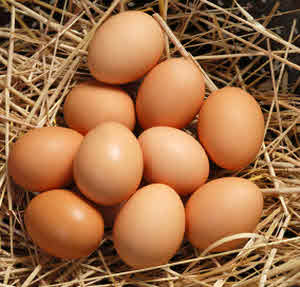 Problems With Eggs – Blood spots, pale yolks, green colour, addled eggs etc.
Problems With Eggs – Blood spots, pale yolks, green colour, addled eggs etc.
On occasion you will find faults with your eggs, and it’s useful to know the causes. Not all problems with eggs can be prevented but it is helpful to know the reason.
Pale Egg Yolk Colour
The yolk colour of eggs naturally varies from light yellow to a deep orange yellow depending on what the hens are eating. Grass and other plants such as clovers and lucerne enhance the yellow colour of the yolk. Ill health can also affect the colour of the yolk.
Green Egg Yolk Colour
Sometimes free ranging hens will produce eggs with green yolks, most frequently in the spring when plants are most lush . The birds should be given more compound feed to reduce the proportion of greens in the diet to correct the problem.
Rotten Eggs
Usually the shell membranes that lie just under the shell protect the egg from microbial and fungal infection. If this layer is damaged or malformed and they get into the egg, rot in patches or whole will occur.
Bubbles in the White
Eggs normally have an air space at the blunt end and the shell is permeable to the air to allow oxygen in to developing chicks. If , however, the inner membrane is damaged the result can be bubbles in the white.
Blood Spots in Eggs
These are small red to reddish brown spots found in or around the yolk. They are usually caused by one of the tiny blood vessels in the ovary breaking at the time when the yolk is released. Often people mistakenly think they indicate a fertile egg and it is the start of a chick forming.
High levels of activity or disturbance, particularly at the time of ovulation are likely to increase the incidence of these blood spots.
Because free range hens may eat grass which contains a substance called rutin that has the effect of stopping bleeding. Free range hens eggs tend to have less blood spots than those from caged or battery kept birds.
Meat Spots in Eggs
Meat spots are usually brown in colour, darker than blood spots, and they are found in the egg white (albumen) rather than the yolk. They consist of small pieces of body tissue, such as the internal wall of the oviduct. Their incidence varies according to bird age and health and also due to breed differences.
In brown shelled eggs, they are more difficult to identify when candling and brown egg laying hens are more likely to produce them than white egg laying hens.
Watery White (Albumen)
Although eggs will remain safe to eat for around 28 days the internal quality begins to deteriorate from the day they are laid. Newer eggs have firm whites that hold their shape. Poor quality whites usually indicate the egg has been laid for longer than you realise. It’s quite amazing how often you come across eggs laid where they shouldn’t be some time ago.
Some newly laid eggs from older birds may have poor quality whites and eggs. Viral diseases can also cause the hen to lay eggs with poor quality whites.
Further Articles All About Eggs
- Araucana Egg Shell Colour & Genetics
- Build Your Own Artificial Lighting System for Winter Egg Production
- Changing Egg Yolk Colour with Feeding
- Double Yolk Eggs – What Causes Double Yolk Eggs?
- Egg Shell Colour Chart by Breed of Hen
- Egg Structure – The Structure of an Egg
- Eggs from Different Species
- Know Your Eggs? – Egg Descriptions Explained
- Marketing Your Surplus Eggs – How to Sell Your Eggs
- Nutritional Value of Eggs – Are Free Range Eggs Better for You?
- Pale Eggs – Egg Shell Colour
- Problems With Eggs – Yolks & Whites
- Saving Money – Economics of Home Produced Eggs
- Selling Your Surplus Eggs at Markets
- Selling Your Surplus Eggs from Home – Farm Gate Egg Sales
- Thin Eggshells – Causes & Cures
- What to do with Surplus Eggs? How to Store Eggs

